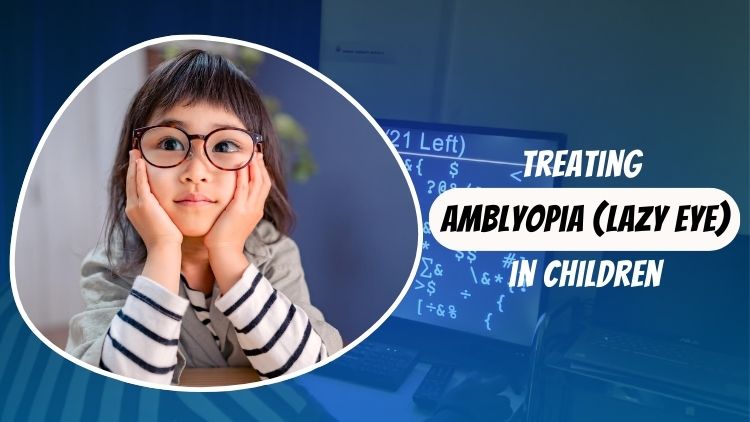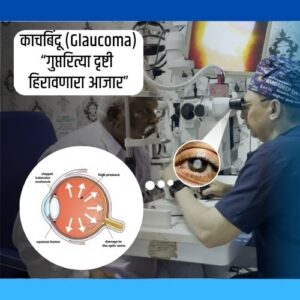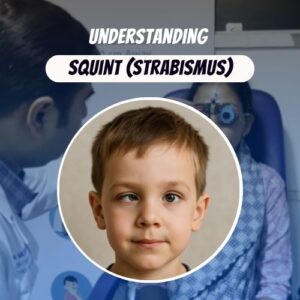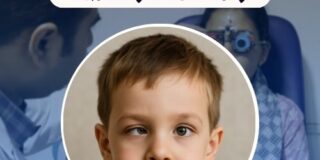Treating Amblyopia (Lazy Eye) in Children: What Every Parent Should Know

Introduction
Has your child been diagnosed with amblyopia, also known as lazy eye? You may be feeling confused or worried, but take a deep breath. You’re not alone, and the condition is very treatable with early and consistent care.
Amblyopia is one of the most common vision problems in children, particularly in early childhood. However, with the right treatment at the right time, your child can enjoy healthy vision for life.
At Nandadeep Eye Hospital, we specialise in lazy eye treatment in children and provide advanced eye care using modern techniques and compassionate support.
What Is Amblyopia?
Amblyopia occurs when one eye fails to develop normal vision during childhood. The brain, always seeking the clearest picture, begins to rely on the stronger eye and “tunes out” the weaker one. Over time, this can lead to permanent vision loss in the weaker eye, even with corrective lenses such as glasses or contacts.
This condition often develops quietly, without obvious complaints, which is why routine eye check-ups for children are so important.
Why does treating amblyopia matter?
If left untreated, amblyopia can impact your child’s ability to learn, play, and enjoy everyday life. But with early intervention, you can help protect their vision for years to come.
Types of Amblyopia
- Strabismic Amblyopia: Caused by eyes that are misaligned (crossed or wandering). The brain ignores one eye to avoid double vision.
- Refractive Amblyopia: Results from a significant difference in focusing power between the two eyes, even if they look straight.
- Deprivation Amblyopia: Occurs when something physically blocks light from entering the eye, such as a cataract.
Signs and Symptoms: What Should Parents Watch For?
Amblyopia can be sneaky—kids rarely complain because they may not realize something’s wrong. Look for:
- Eyes that don’t line up (crossed or drifting outward)
- Squinting or tilting the head often
- Trouble judging distances (poor depth perception)
- Favoring one eye (covering or closing one eye while focusing)
- Frequent eye rubbing or complaints of blurry/double vision
If you notice any of these symptoms, schedule a paediatric eye checkup at Nandadeep Eye Hospital without delay.
How Is Amblyopia Diagnosed?
Early detection is crucial. Many cases are found during routine pediatric eye exams. Eye doctors use gentle, age-appropriate tests to:
- Measure each eye’s vision
- See how well the eyes work together
- Check for any misalignment or focusing issues
Routine screenings, especially before school starts, can catch amblyopia before it affects learning or development.
Treatment Options for Amblyopia in Children
1. Corrective Eyewear
Glasses or contact lenses can correct focusing problems like nearsightedness, farsightedness, or astigmatism. Wearing them consistently helps the brain start using both eyes more equally.
2. Patching (Occlusion Therapy)
Covering the stronger eye with a patch for several hours a day forces the weaker eye to work harder. Make patching fun—let your child pick out colorful patches or use reward charts to encourage cooperation.
3. Atropine Eye Drops
These drops blur vision in the stronger eye, nudging the weaker eye to take over. Some kids find drops easier than wearing a patch, though they can cause mild irritation or light sensitivity.
4. Vision Therapy
Think of vision therapy as “physical therapy” for the eyes and brain. Through fun exercises and games—both in-office and at home—vision therapy can:
- Strengthen the weaker eye
- Improve eye coordination
- Boost skills like depth perception and tracking
Vision therapy often works best when combined with patching or glasses, helping your child make faster and more lasting progress.
Surgical Options
Surgery isn’t usually the first step, but it can be needed if there’s a physical problem, like:
- Eye misalignment (strabismus): Surgery can help straighten the eyes so they work together.
- Cataracts or other blockages: Removing these lets light reach the retina.
Remember, surgery alone doesn’t “cure” amblyopia. Follow-up treatments—like patching or vision therapy—are still needed to retrain the brain.
Why Early Treatment Is Best for Amblyopia?
Children under the age of 7 respond best to amblyopia treatment because their visual system is still developing. However, children aged 8 to 14 can also show significant improvement if treatment is consistent.
Without treatment, amblyopia can cause irreversible vision loss, which cannot be corrected later in life, even with glasses or surgery.
Support Your Child Throughout Treatment
Treating amblyopia takes patience, but your encouragement is powerful. Here’s how you can help:
- Create a routine: Make treatment part of daily life.
- Stay positive: Use praise, stickers, or small rewards to boost your spirits.
- Talk openly: Help your child handle questions from friends, especially if they’re wearing a patch.
Consistency is key—skipping treatments can slow or undo progress.
Frequently Asked Questions on Amblyopia (Lazy Eye)
Is amblyopia permanent?
No—if caught and treated early, vision often improves significantly or is completely restored. If left untreated, it can become permanent.
Can amblyopia come back after treatment?
Sometimes. That’s why regular follow-up visits are important.
How will I know if the treatment is working?
Your eye doctor will monitor your child’s progress with follow-up exams and vision tests.
Do screens make amblyopia worse?
Screens don’t cause amblyopia, but too much screen time can strain the eyes. Encourage regular breaks and plenty of outdoor play.
Conclusion
Amblyopia is common, but it’s also highly treatable—especially when caught early. By staying alert to the signs and sticking with the treatment plan, you can help your child build strong, lasting vision.
If you have any concerns about your child’s sight, don’t wait. Book an eye exam with a kids’ eye specialist near you. Early action today can make a world of difference for your child’s tomorrow.
More Posts

Everything You Should Know About Pediatric Eye Exams

काचबिंदू (Glaucoma): नियमित नेत्रतपासणी का आवश्यक आहे?







